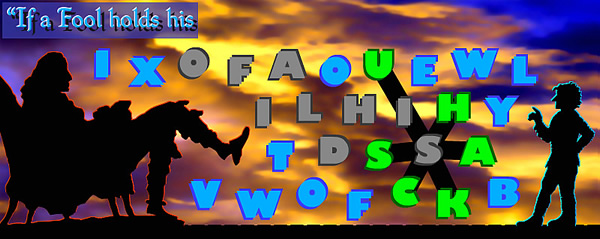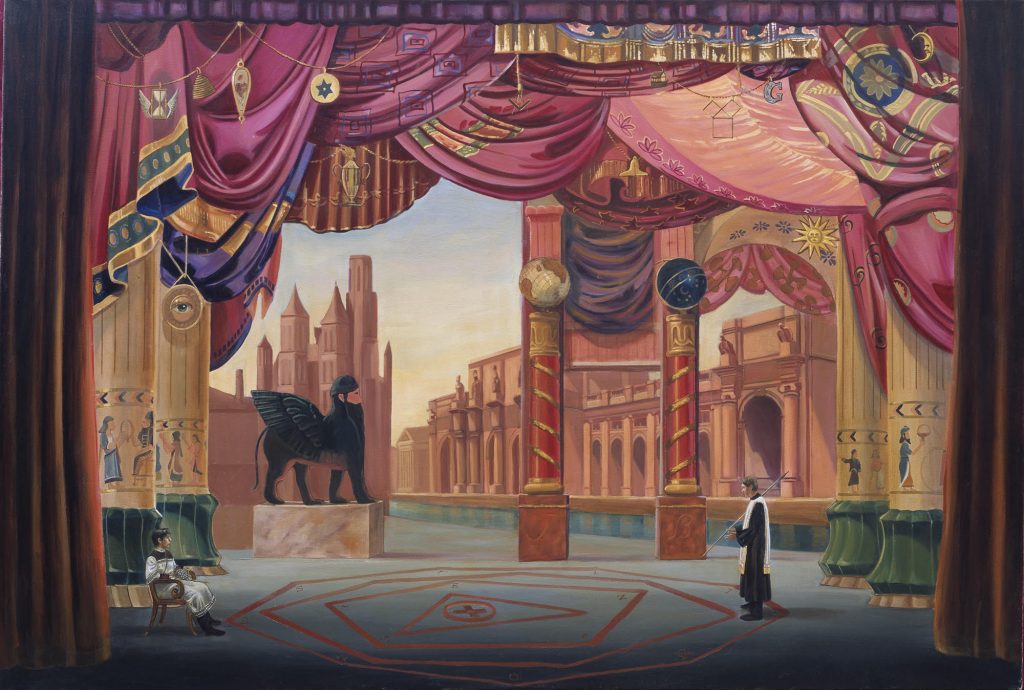
What an awesome pleasure it is to have the opportunity of asking Six Questions to the Award-Winning Puzzle and Game Designer, Cliff Johnson. Cliff gained wide recognition after creating his captivating computer puzzle game, The Fool’s Errand, in 1987. From this successful endeavor of weaving storytelling in with puzzle solving, he has gone on to engineering a vast number of other highly creative and ingenious projects.
His achievements have led him to becoming known as one of the most masterful puzzle designers. Major companies, like Disney, Warner Bros, and Mattel, have sought his expertise for producing online treasure hunts and games. As some here may know, he has also crafted the treasure hunt found in The Astana Challenge, which is currently going on now. A prize valued at $30,000 waiting to be claimed. It is so exciting for the chance to learn more about Cliff and his innovative ventures in the following Six Questions!
Enjoy!
Six Questions with Cliff Johnson:
- 1Q) First, thank you so much for participating in Six Questions with MW. As a website who delves into puzzles, games, and mystery, it’s a wonderful opportunity to chat with a famed architect of those. I suppose my initial question must be, how did you get involved in puzzle and game design? And what do you enjoy about crafting mind challenging bewilderments for others?
Thank you as well.
In 1970, my pal Dave subscribed to GAMES Magazine, and after he had penciled in all the answers, he would pass them along to me, for I found both the style of the puzzle graphics and the fait accompli solutions to be fascinating.
In 1973, the movie “The Last of Sheila,” written by Anthony Perkins and Stephen Sondheim (both puzzle aficionados), inspired me to stage mystery game and treasure hunt puzzle parties for family and friends.
In 1979, Kit Williams’ book Masquerade prompted me to create The Fool’s Errand as an unpublished puzzle book, the key difference being that the former took years to solve and had a substantial prize, and the latter would take only a few days to solve and had no prize. Like GAMES Magazine, the solving was its own reward.
In 1984, I bought a Mac 512K, and by 1987, I had created “The Fool’s Errand,” arguably the first computer metapuzzle, or as Neil Shapiro wrote in MacUser Magazine, “the whole buffalo,” meaning that everything in the game had to be used eventually.
My attraction to creating puzzles is to present a challenge with only one possible solution. By comparison, a game has a goal and provides many methods and strategies to accomplish that goal. In a nutshell, puzzles offer me complete authorship.
I should add that my puzzle interest is inseparable from my Tinker Toy enjoyment of programming puzzles on the computer. Both of my Armchair Treasure Hunts benefited from an array of such behind-the-scenes tools.
http://thefoolserrand.com/02-FE/color-version.htm
http://thefoolandhismoney.com/06-FM/tour/02-seventh-house.htm

- 2Q) It seems to me a game designer must discover a balance between offering fun challenges with items of entertaining value. Would you agree? Or what do you feel are some of the most important things to consider while creating a puzzle? What do you like to include or have players engage in? How do you keep frustration at a minimum, and fun at a maximum? Or isn’t that something you consider?
A puzzle begins with a “huh?” and ends with an “aha!”
With my interactive computer puzzles, I like to present an alluring challenge with plenty of moveable parts and intriguing graphics, prompting the initial response, “What on earth do I do with this?”
Then there’s the experimental phase. Poking this and that. Discovering what does what. Finding what tricks there are to be found.
Finally, observation and intuition lead to the “aha!” This could be realizing the answer itself, or determining what correct steps are needed to find that answer.
Since I pose a wide variety of puzzles in my games, I’ve long since faced the fact, “you cannot please everyone all the time.” Some folks like word puzzles. Others prefer logic puzzles. And some relish arcade puzzles.
I put all of them, and more, into every game. The possible frustration of this is offset by the fact that many people play my games in pairs: parent and child, friends and lovers, etc. What baffles one person may well be the other person’s cup of tea. This not only creates satisfying puzzle play, but allows for joyous and raucous social interaction.
When I set about to create a puzzle, my foremost concern is, “Could I solve this?” I’m not the sharpest pencil in the box when it comes to solving puzzles, so I figure if it makes sense to me, then give it a whirl. This instinct has served me well since the beginning.
- 3Q) Besides being the artful designer for the award-winning game, The Fool’s Errand, and its sequel, The Fool and his Money (2012), you are also known for developing the notorious 2002 treasure hunt in David Blaine’s book, Mysterious Stranger. The winner of your cleverly hidden location of a golden orb won $100,000. Do you feel the hunt went on and was solved as planned? What did you enjoy most about creating and watching that hunt unfold?
There were many twists and turns as the treasure hunt unfolded.
About 8 months in, a website surfaced where people freely exchanged clues and answers back and forth. I tracked their progress as they solved the 15 visual codes and deciphered the 41 arcane sentences. At this point, I figured someone would claim the prize within a month or two.
Then David Blaine wanted me to devise a one sentence clue that he could announce on The Larry King Show. This clue, all by itself, was to be sufficient to locate the treasure.
The hunt dragged on another 8 months as folks tried to reconcile The Larry King Clue with the 41 sentences to no avail. So I’ll never know if the original challenge could have been solved as I had intended. Lord love a duck.
The woman who claimed the prize joined the hunt late in the game and solved it in 6 weeks, astutely interpreting The Larry King Clue. She tells a fine tale on my website.
I enjoyed creating the 15 unique visual codes and the riddle of the 41 sentences. It was some consolation that one of the players sent me a detailed deconstruction of my original challenge, sans Larry King. This is also on my website.
Watching the hunt unfold was a daily amusement. There were two camps of solvers. The ones who were on the right track. And the others who were Just Blaine Crazy, sending in elaborate solutions based on obscure references throughout the book.
All of this and more can be found here:
http://thefoolsparadise.com/09-TH/index.htm
- 4Q) Currently, another Armchair Treasure Hunt of your masterful design is going on. It is called the Astana Challenge and found within the book, Astana: Architecture Myth and Destiny, by Dr. Frank Albo. The winner receives a prize valued at around $30,000. How did you get involved in this project, and can you say if the difficulty level is similar to that of Mysterious Stranger’s hunt? Do you feel it is easier or more difficult? Do you know if anyone is coming close to solving it?
Frank found my website for the David Blaine treasure hunt and then e-mailed me. We had many lively conversations on the telephone as we zeroed in on the final concept.
I’ve written and deleted many attempts to answer your other questions, but in the end, I realize that I cannot make any observations or comparisons without revealing a hint or two about Astana.
http://thefoolsparadise.com/09-TH/astana/index.htm

- 5Q) It seems you have created numerous treasure hunts, but I wonder have you ever personally worked on any yourself, like Masquerade, In Search of the Golden Horse, or another? What are your thoughts about an audience for these; do you feel most people are willing to take up challenging missions to discover treasure or only a few diehard puzzle fans? Do you have any advice to offer someone interested in designing an Armchair Treasure Hunt, puzzle, or computer style game?
Although I’ve become a connoisseur of puzzles, ironically, I don’t play puzzles for enjoyment.
I bought Masquerade, stared at it, decided, “Well, this is impossible,” and stuffed it on my bookshelf. Many years later, I bought the paperback solution, read it with interest, and concluded, “I never would’ve figured that out if my life depended on it.”
I think the interest in a given Armchair Treasure Hunt is in direct proportion to the prize. The greater the reward, the greater the frenzy. Who could resist a golden hare buried in England? Or a secret treasure hidden in the Rocky Mountains? For me, it’ll always be the “Big W” from It’s a Mad Mad Mad Mad World.
That being said, mysteries attract a devoted following in books and movies. I feel that the same could be true with Armchair Treasure Hunts, regardless of the prize. The trick, I feel, is to give the player a sense of purpose. Where do I start? What do I do? For me, the greatest obstacle are red herrings, which are counterproductive to the flow of enjoyment.
Imagine a 500-piece jigsaw puzzle with 50 additional pieces that don’t belong? Or a cryptogram with double the letters than are necessary? Both of these puzzles are solvable, but it would limit the size of the intended audience.
My goal for The Fool’s Errand was to create a puzzle adventure where every aspect of it was part of the grand puzzle. No red herrings. And the prize was an animated finale. The player always had something to do and a general sense of where they were heading. Average playing time was a month.
So, for me, creating Armchair Treasure Hunts is an engaging change of pace, but not my preferred genre.
Advice to future designers: follow your passion and then just do it.
- 6Q) Your life seems to be filled with lots of puzzling fun and thrills. Are you currently working on any other Armchair Treasure Hunts or computer games? And what else do you enjoy doing when not crafting baffling and mystifying riddles?
No Armchair Treasure Hunts or computer games on the horizon, however, I have taken an interest in designing puzzles for my monthly newsletter.
Spell an antonym, a temperature, and an opener to reveal a secret message.

http://www.thefoolsgold.com/12-FG/024/index.htm
My pie-in-the-sky ambition is to create internet treasure hunts with interactive puzzles and sponsored prizes.
Otherwise, I play board games, watch movies, and sleep.
Thanks so much, Cliff. Excellent answers! I love how you describe the puzzle creation process starting with a ‘huh?’ and ending with an ‘aha’. So very true. The elements between those two moments are crucial and it seems you have successfully mastered exactly what to put there. (And not to put there, like those red herrings).
I appreciate you taking time to share your perspectives on puzzle design and thoughts about armchair treasure hunts with us. Your remarks have been wonderfully insightful and a joy to read. Your passion shines through.
And, I must add – I love your newsletter! We all should take time for laughs and muses. Definite treasures found in there!
Thank you!
If you missed the link above, be sure to check out Cliff’s website: The Fool and His Money! Lots of fun adventures to be found there!
